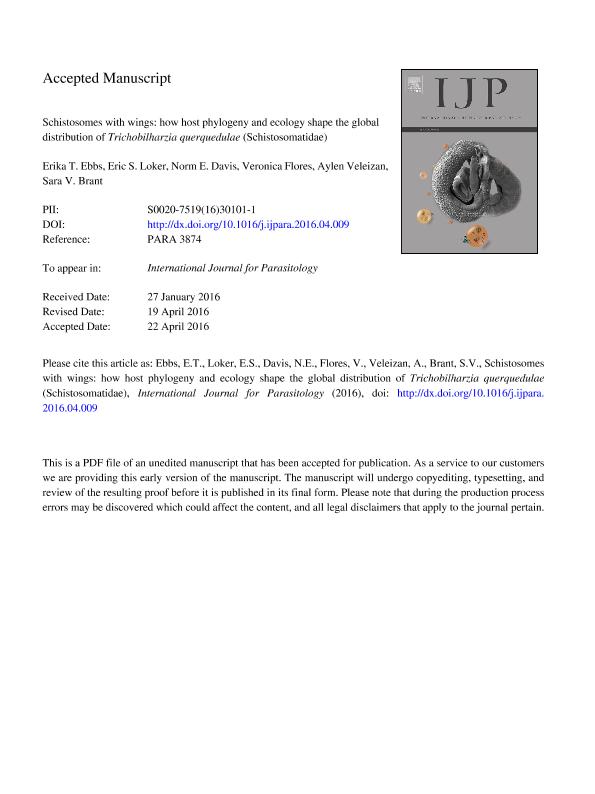Mostrar el registro sencillo del ítem
dc.contributor.author
Ebbs, Erika T.
dc.contributor.author
Loker, Eric S.
dc.contributor.author
Davis, Norm E.
dc.contributor.author
Flores, Verónica Roxana

dc.contributor.author
Veleizán, Aylén Anabella

dc.contributor.author
Brant, Sara V.
dc.date.available
2019-03-07T20:05:33Z
dc.date.issued
2016-09
dc.identifier.citation
Ebbs, Erika T.; Loker, Eric S.; Davis, Norm E.; Flores, Verónica Roxana; Veleizán, Aylén Anabella; et al.; Schistosomes with wings: how host phylogeny and ecology shape the global distribution of Trichobilharzia querquedulae (Schistosomatidae); Elsevier; International Journal for Parasitology; 46; 10; 9-2016; 669-677
dc.identifier.issn
0020-7519
dc.identifier.uri
http://hdl.handle.net/11336/71203
dc.description.abstract
Migratory waterfowl play an important role in the maintenance and spread of zoonotic diseases worldwide. An example is cercarial dermatitis, caused when larval stages of schistosomes that normally develop in birds penetrate human skin. Members of the genus Trichobilharzia (Schistosomatidae), transmitted mainly by ducks, are considered to be major etiological agents of cercarial dermatitis globally. To better understand the diversity and distribution of Trichobilharzia spp., we surveyed ducks from the United States, eastern Canada, Argentina, South Africa and New Zealand. To aid in species identification of the Trichobilharzia worms recovered, regions of the Cox1, ND4 and ITS1 were sequenced. Furthermore, we provide molecular phylogenetic evidence for the cosmopolitan distribution and trans-hemispheric gene flow for one species, Trichobilharzia querquedulae, previously thought to be restricted to North America. These new samples from endemic non-migratory duck species indicate that T. querquedulae transmission occurs within each of the regions we sampled and that it is specific to the blue-winged + silver teal duck clade. Prevalence within this host group is >95% across the known range of T. querquedulae, indicating that transmission is common. Genetic divergence is evenly distributed among continents, and no phylogenetic structure associated with geography was observed. The results provide strong support for the global distribution and transmission of T. querquedulae and represent, to our knowledge, the first report of a cosmopolitan schistosome confirmed by genetic data. These data are the first known to support trans-hemispheric genetic exchange in a species responsible for causing cercarial dermatitis, indicating that the epidemiology of this group of poorly known zoonotic parasites is more complex than previously expected.
dc.format
application/pdf
dc.language.iso
eng
dc.publisher
Elsevier

dc.rights
info:eu-repo/semantics/openAccess
dc.rights.uri
https://creativecommons.org/licenses/by-nc-nd/2.5/ar/
dc.subject
ANAS
dc.subject
CERCARIAL DERMATITIS
dc.subject
EMERGING DISEASE
dc.subject
SCHISTOSOME
dc.subject
TRICHOBILHARZIA
dc.subject
ZOONOSIS
dc.subject.classification
Otras Ciencias Biológicas

dc.subject.classification
Ciencias Biológicas

dc.subject.classification
CIENCIAS NATURALES Y EXACTAS

dc.title
Schistosomes with wings: how host phylogeny and ecology shape the global distribution of Trichobilharzia querquedulae (Schistosomatidae)
dc.type
info:eu-repo/semantics/article
dc.type
info:ar-repo/semantics/artículo
dc.type
info:eu-repo/semantics/publishedVersion
dc.date.updated
2019-02-12T16:57:40Z
dc.journal.volume
46
dc.journal.number
10
dc.journal.pagination
669-677
dc.journal.pais
Países Bajos

dc.journal.ciudad
Amsterdam
dc.description.fil
Fil: Ebbs, Erika T.. University of New Mexico; Estados Unidos
dc.description.fil
Fil: Loker, Eric S.. University of New Mexico; Estados Unidos
dc.description.fil
Fil: Davis, Norm E.. University of Otago; Nueva Zelanda
dc.description.fil
Fil: Flores, Verónica Roxana. Consejo Nacional de Investigaciones Científicas y Técnicas. Centro Científico Tecnológico Conicet - Patagonia Norte. Instituto de Investigaciones en Biodiversidad y Medioambiente. Universidad Nacional del Comahue. Centro Regional Universidad Bariloche. Instituto de Investigaciones en Biodiversidad y Medioambiente; Argentina
dc.description.fil
Fil: Veleizán, Aylén Anabella. Consejo Nacional de Investigaciones Científicas y Técnicas. Centro Científico Tecnológico Conicet - Patagonia Norte. Instituto de Investigaciones en Biodiversidad y Medioambiente. Universidad Nacional del Comahue. Centro Regional Universidad Bariloche. Instituto de Investigaciones en Biodiversidad y Medioambiente; Argentina
dc.description.fil
Fil: Brant, Sara V.. University of New Mexico; Estados Unidos
dc.journal.title
International Journal for Parasitology

dc.relation.alternativeid
info:eu-repo/semantics/altIdentifier/url/http://www.sciencedirect.com/science/article/pii/S0020751916301011
dc.relation.alternativeid
info:eu-repo/semantics/altIdentifier/doi/https://doi.org/10.1016/j.ijpara.2016.04.009
Archivos asociados
